Speaking to some of the creatives – writers, artists, and games designers – involved in ">Mothership is like lifting the lid on the hardcore punk underground in whatever midwestern town you care to name.
You can picture it. There’s a basement venue where everyone plays plastered with scratchy posters like ransom notes from kidnappers. There’s a ‘hero band’ who were the first to break out of the scene and bag a split 7” with, I don’t know, Starkweather. There’s a vibrant ecosystem, other bands rising on that same tide, a local correspondent for Maximum Rocknroll or maybe a local radio station that plays “real music” after 10 pm on Mondays, and a friendly neighborhood record label/distro run out of someone’s garage.
Most of all there’s a gentle, patient sense of this has always been awesome, it’s just that you’ve only just noticed.
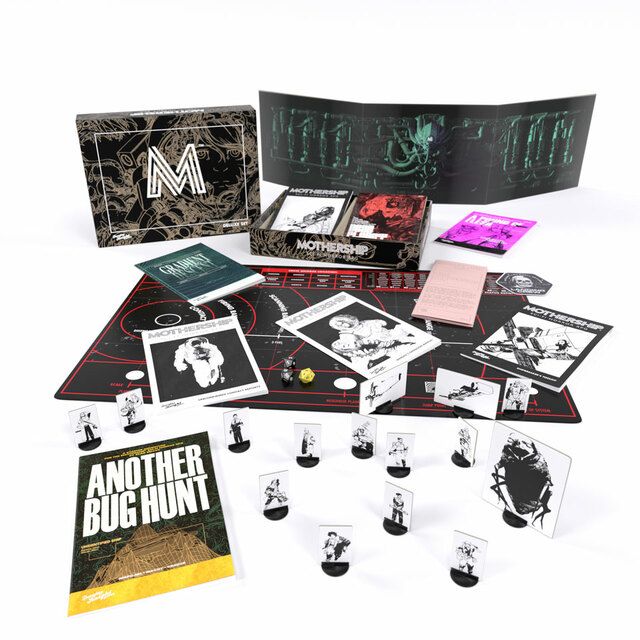
In the case of Mothership, what started with a 41-page Mothership: Player’s Survival Guide released in 2018 by Tuesday Knight Games quickly became a word-of-mouth hit, nominated for Best Rules in the 2019 Ennie Awards alongside the latest incarnations of established systems like Chaosium’s Call of Cthulhu and Cubicle7’s Warhammer Fantasy Roleplay, and winning Best Game. A rules-lite D100 system, Mothership openly takes its pointers from Ridley Scott’s Alien and plunges players into a world of tension, terror, and almost-certain death in the uncaring void.
“We were lucky and we were prepared to be lucky,” explains Sean McCoy, writer, illustrator, and half of Tuesday Knight Games. “A number of factors broke our way. We have an amazing team, and indie RPG stars like Jarrett Crader, Fiona Geist, Donn Stroud, and Luke Gearing all threw in heavy support early on when we were no one. We were still in the last days of G+ which helped us with early adopters. We were one of the first tabletop companies to really make Discord a priority. And we followed up our initial release with module after module after module.”
“I think it’s really good,” says Mark Boardman, host of the Dungeonpunx podcast and early fan of Mothership. “The fear/stress mechanic works really well – you can ‘feel’ tension ramping up with the way it handles your dice rolls. [We] had a marine who was failing his stress rolls and I was standing up screaming ‘Marine… MARINE… WHAT THE FUCK ARE YOU DOING!?’”
Tim Obermueller, who wrote the module The Burning of Carbex, says: “Despite not having any kind of canon setting, I think what makes Mothership special is that anyone who’s even created a character in Mothership will have a sense of the kind of universe they’ll be in. Like I can talk to any MoSh player about Laser Cutter shenanigans and we can immediately bond over that.”
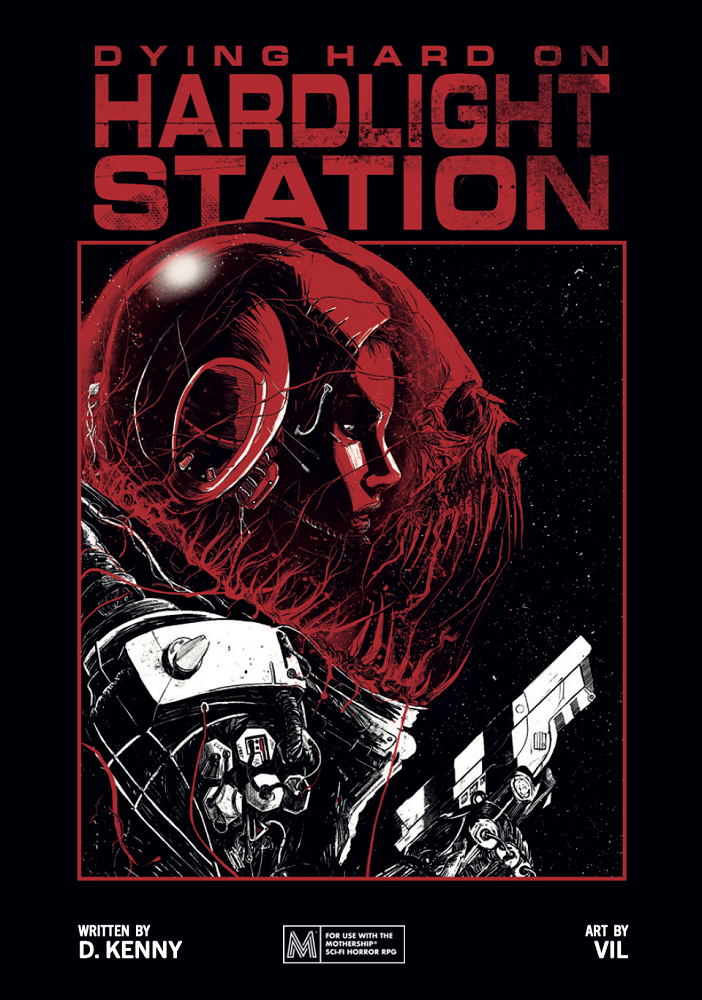
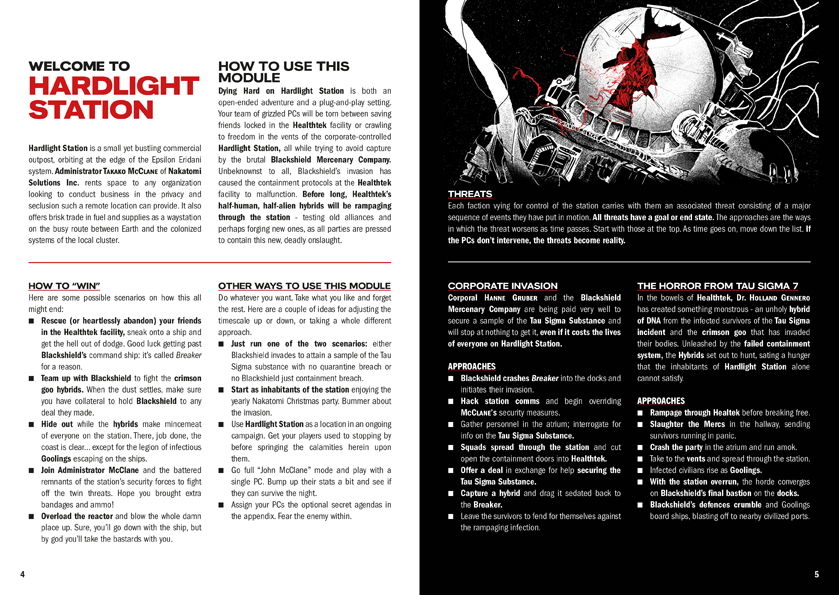
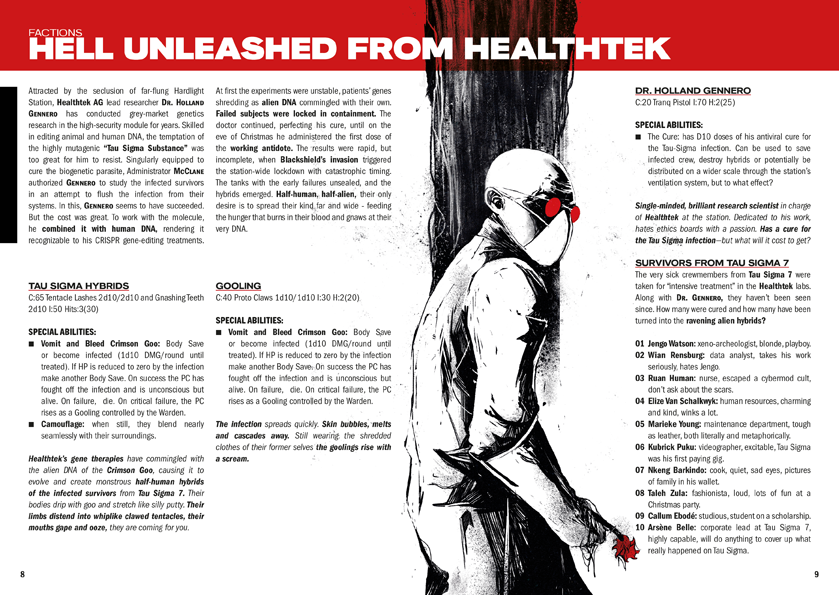
Dave Kenny, who authored the supplements Dying Hard on Hardlight Station and Nirvana on Fire, is also an evangelist for the system, describing the ‘secret formula’ as “its clear vision both in its blue-collar, hard sci-fi aesthetic and in the unity of its stripped-down rules and matching graphic design.” He continues:
“Mothership is a package where every part is aligned. The rules, the layout, the inspirations – everything comes together in a tight, coherent whole that bucks the trend of the bloated game books you see for so many other systems.
“Every item in every first-party Mothership release has been carefully thought through and stripped to its barest essentials to maximize clarity and speed of use. It’s an easy and fun game to run and a pleasure to read – any one of the published modules is packed with brain fuel and you can run them straight or steal ideas for your own stuff. It’s very encouraging of DIY – and among the other things I mentioned I think that encouragement to make it your own is another critical strength of the system making it so popular.”
“Mothership makes no secret of the fact that its core rules fit on a single page,” says Alfred Valley, the creator of the solo adventure Thousand Empty Light. “And therein lies its strength. It’s a small game that can evoke the feeling of something much grander; a game experience that expands to fit the cultural enormity of a lot of nostalgic sci-fi horror, like Alien, The Thing, and so on. The graphic design of the Mothership character sheet alone helps evoke this feeling, with its tantalizing skill trees.”
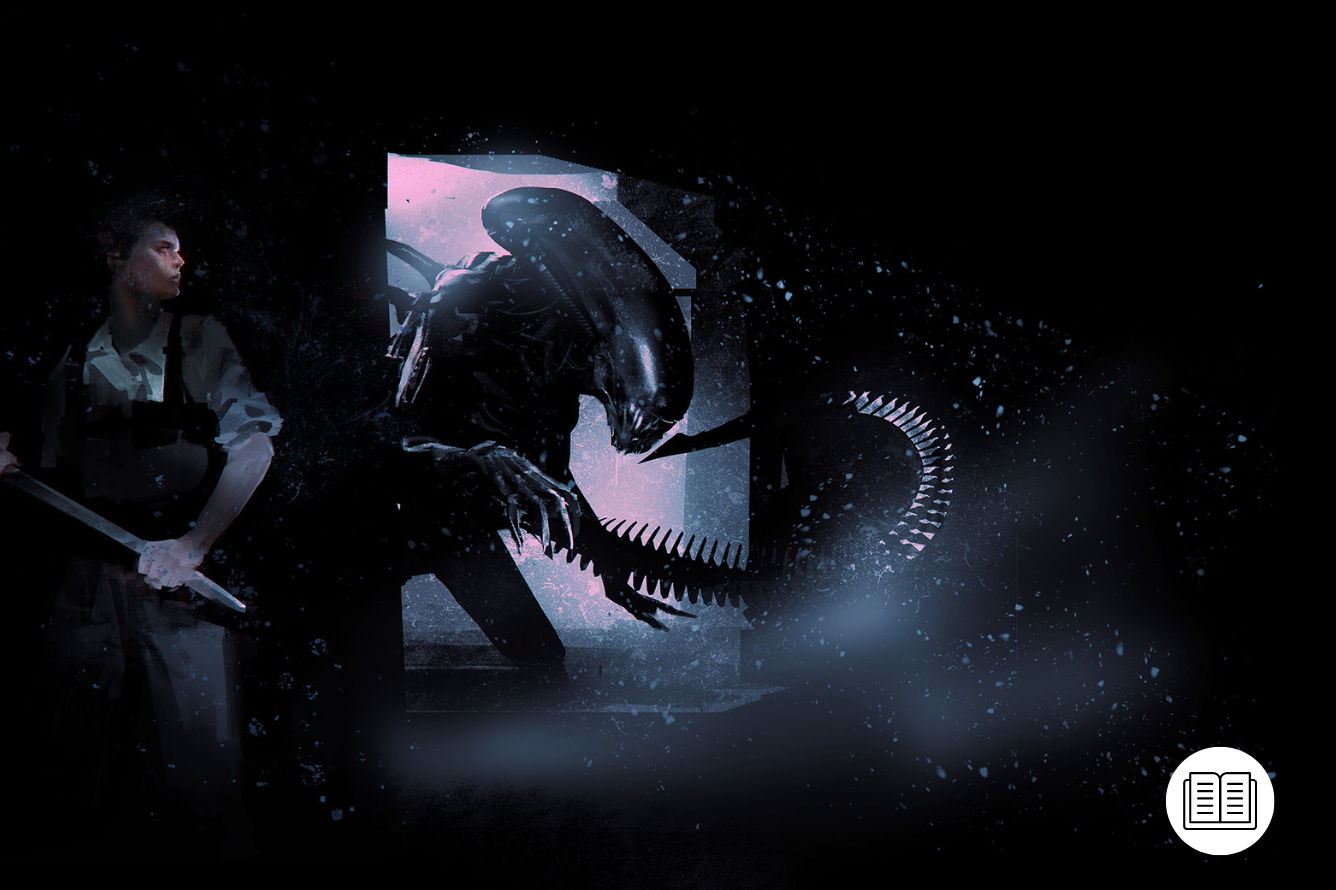
The Birth of Mothership
The pulse rifle-packing stepchild of the OSR – old school revival – movement that looked to TSR-era Dungeons & Dragons for inspiration, Mothership was born from the realization that the classic dungeon crawl works just as well in space. I mean, James Cameron’s Aliens is basically a dungeon crawl in space. Dead Space is literally a dungeon crawl in space.
“I came across this idea of exploring a giant alien mothership almost like a hex crawl,” says McCoy, “and I started to realize all the things I loved about OSR games—high stakes, lethality, exploration, puzzle solving—all of those were prevalent in sci-fi horror. And best of all that genre had been woefully underserved in RPGs at the time. We got in at the very beginning of a trend in RPGs, now there are maybe a dozen or more sci-fi horror games on the market. So from this idea, I basically decided to spend zero time on the system, which felt like quicksand. I used a bare-bones D100 system because I knew it would work and because percentiles sound science fiction-y. I added one small stress and panic subsystem to make the core unique.”
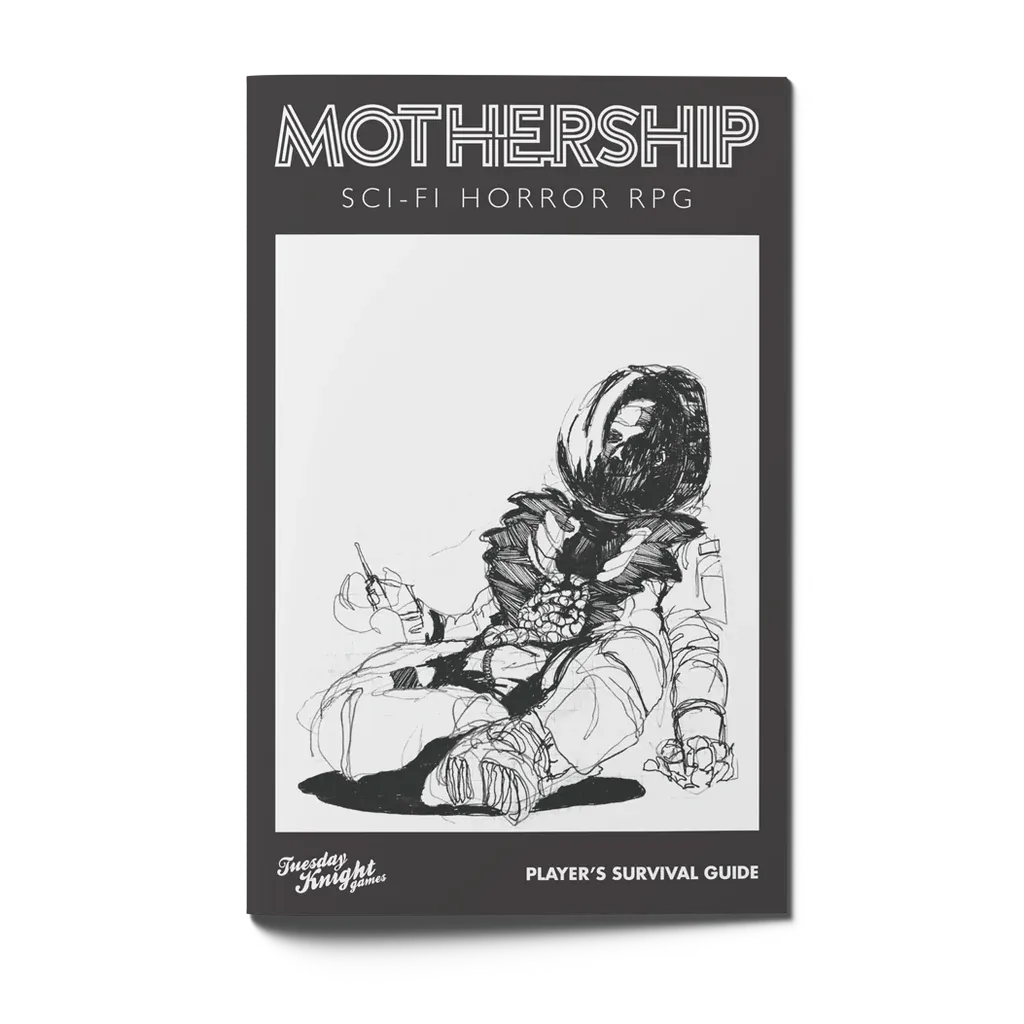
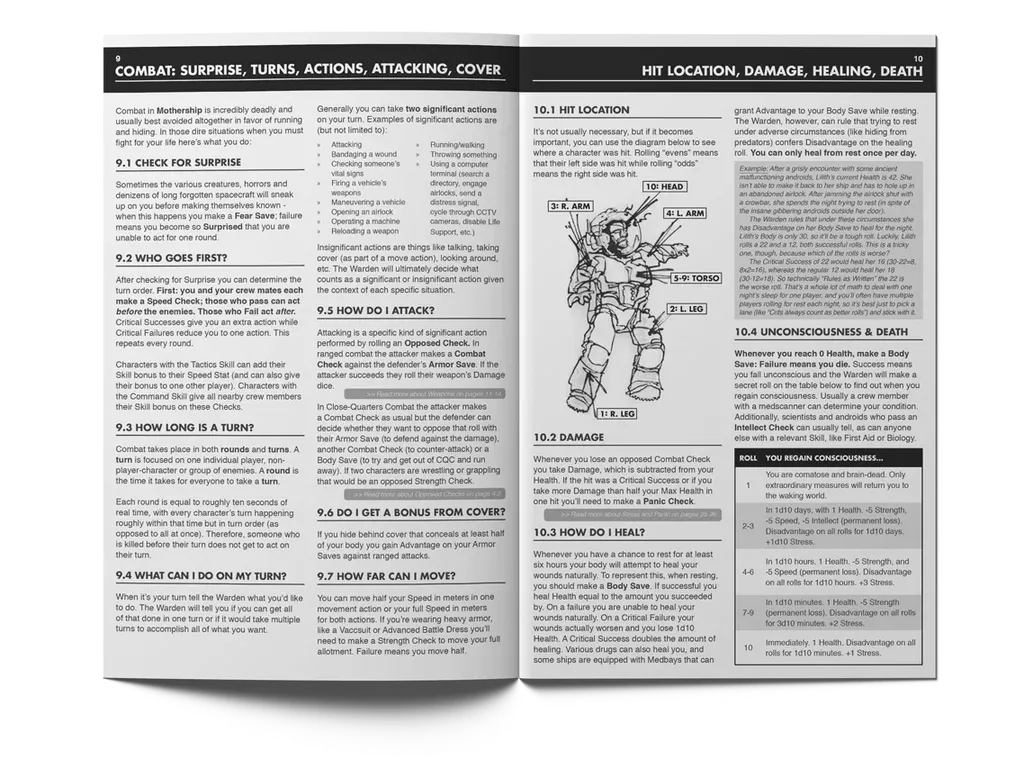
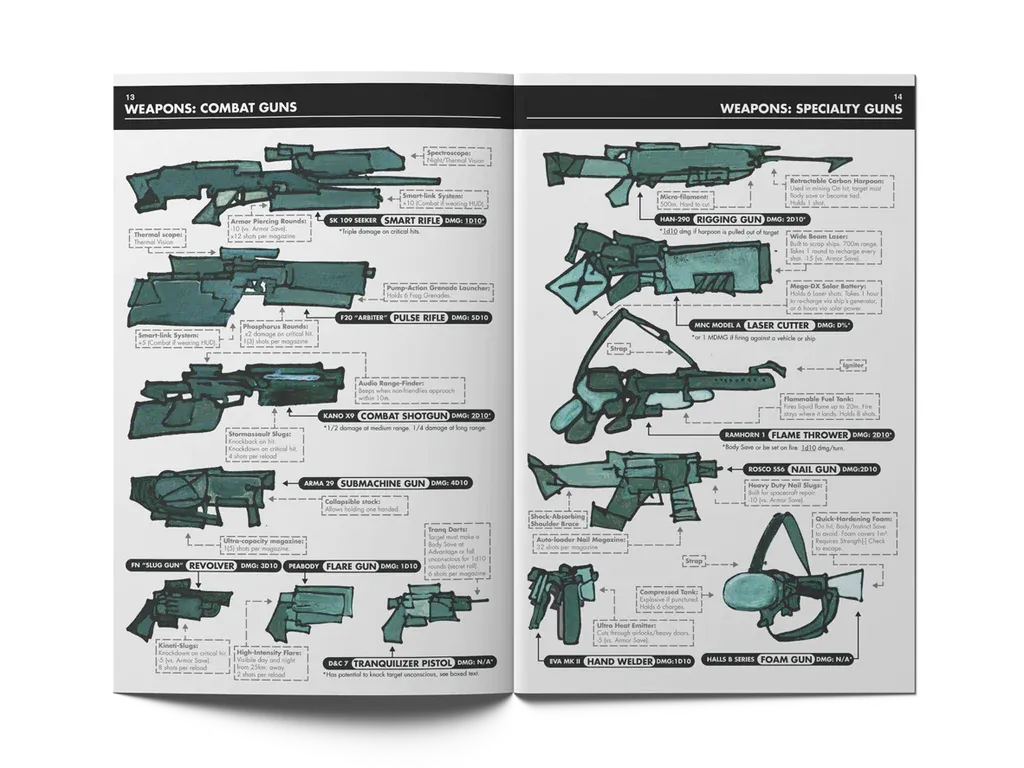
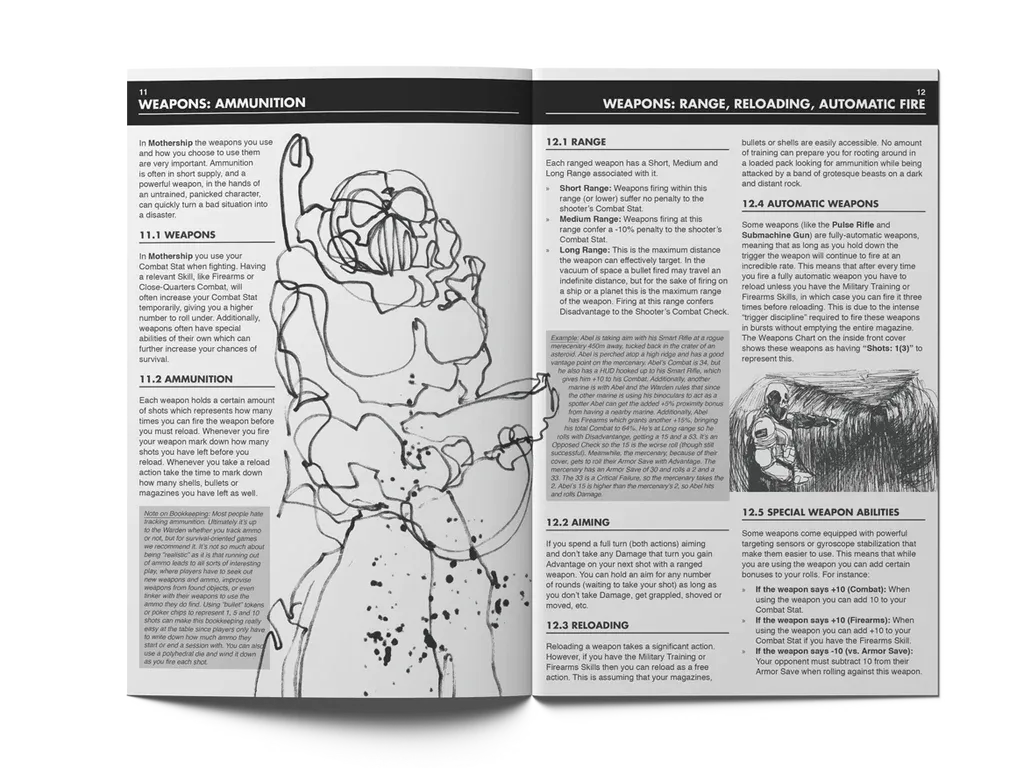
The first game of Mothership was played at GenCon 2017 with a small group of friends and a few “scraps of graph paper.” The basic rules set was condensed into a “pocketmod” – designed to be printed onto a single sheet of paper and folded to create a simple booklet – that McCoy hoped to expand to a full-blown zine.
“This way I had clear markers along the way for when something was finished,” he says. “With the pocketmod for example, I thought ‘Well, I can just take every paragraph and turn that into a whole page with art and formatting, and then I’ll have a whole zine.’ So going into that first game I thought, well it’s a small game but it’s a finished one. I went through every annoying first game thing you could think of. Distracted players, people running late, people ordering food, people not taking it seriously – and still, the game worked! It was in retrospect the best kind of environment for what I needed because I know, no matter what else, the core engine of the game ran. And that encouraged me enough to press forward.”
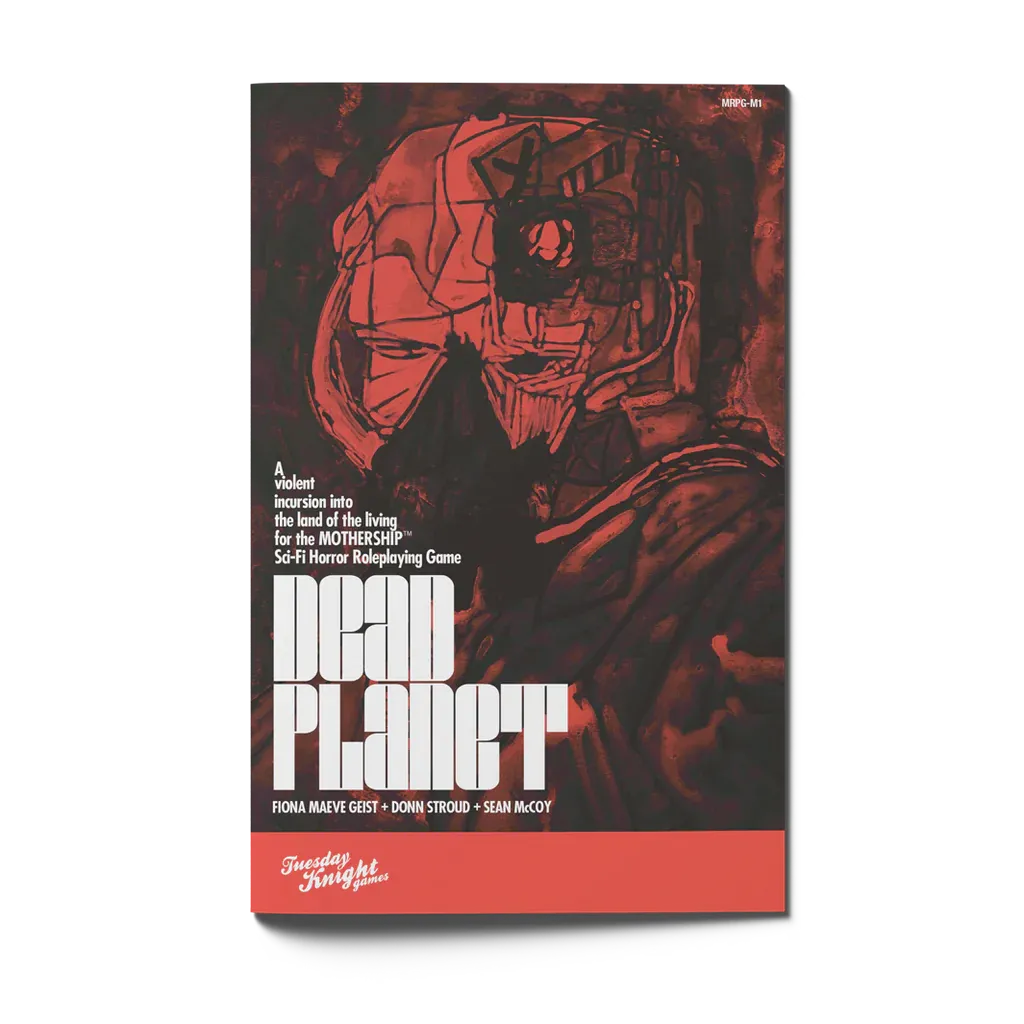
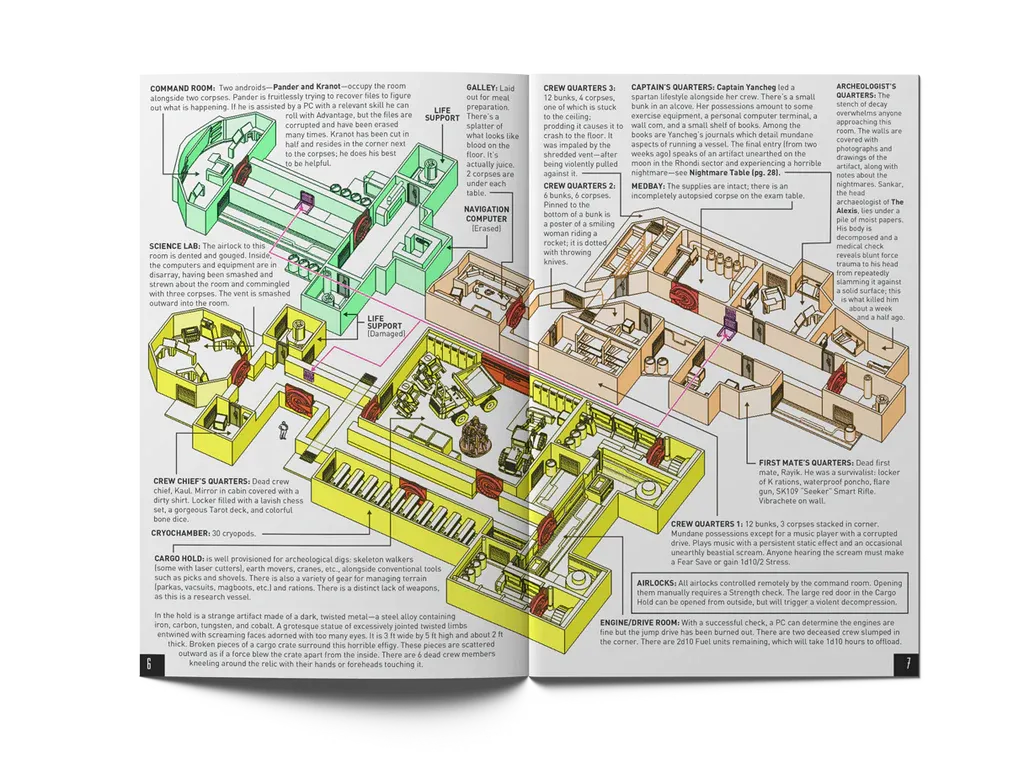
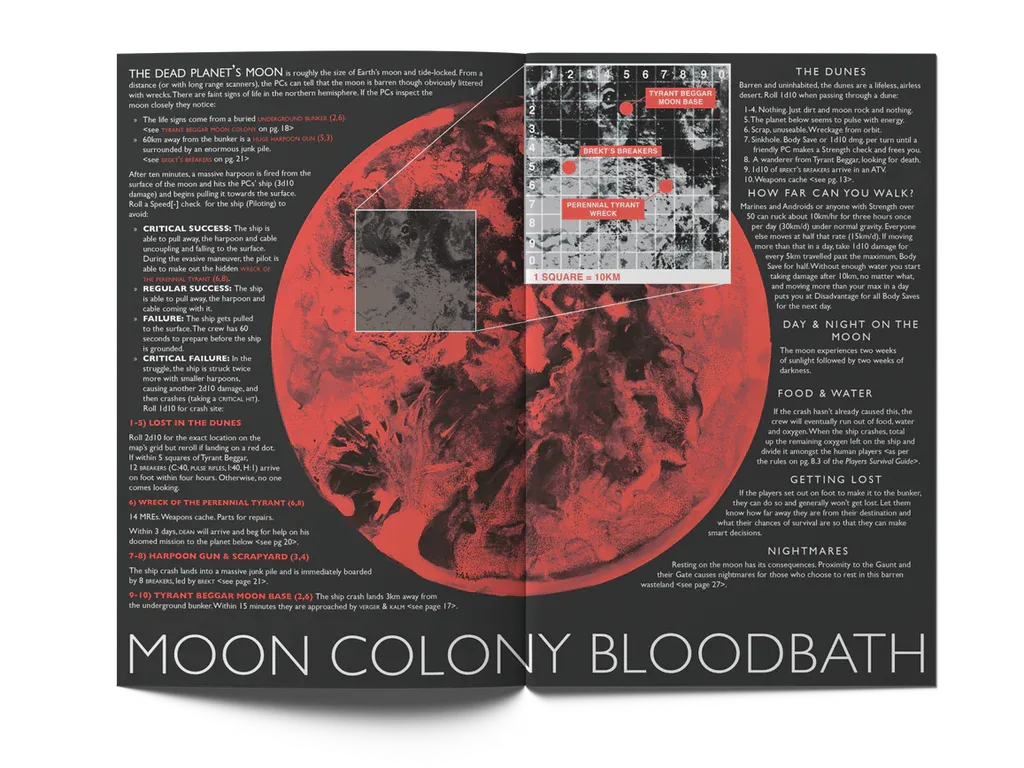
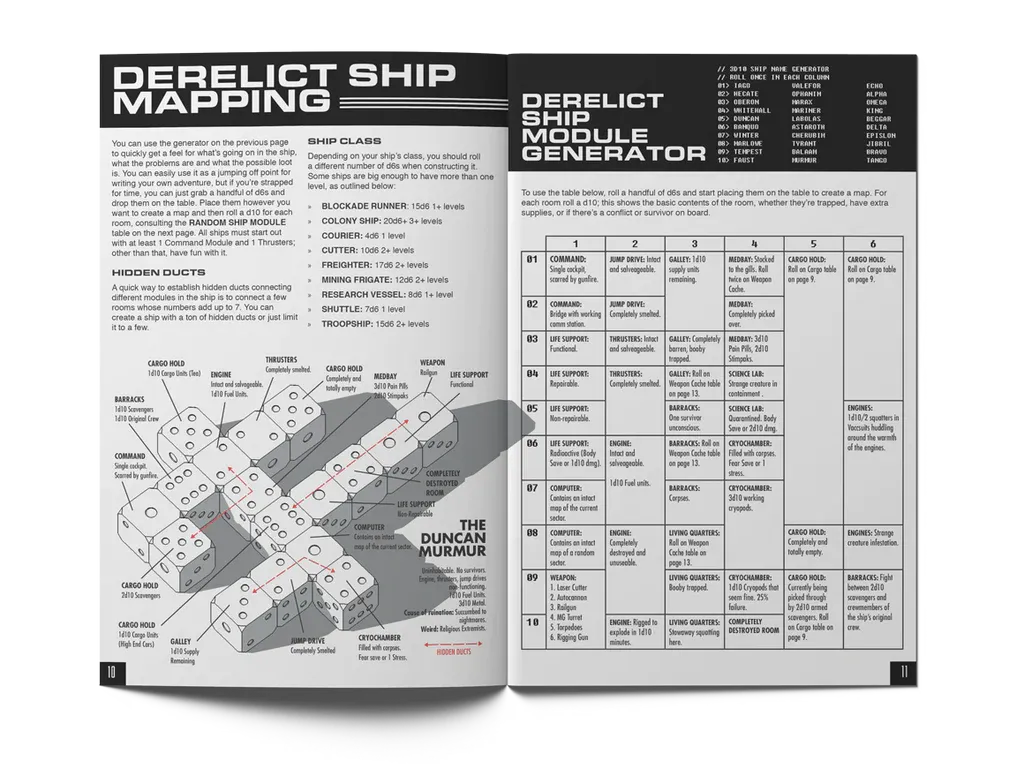
McCoy’s art style, a sort of frantic watercolor-against-the-clock that fits the game’s sense of unease and immediacy, made Mothership stand out immediately, but it was a design decision based on practicality.
“Style is all about accentuating your strengths and distracting from your weaknesses,” he explains. “This kind of back-bending contortion becomes a look that is wholly your own. I draw with a sharpie and paint over it which gives this uncontrolled, permanent, bleeding look that I like. I don’t have a lot of technical skills when it comes to anatomy and figure drawing and perspective, so I make up for that by focusing on gesture and texture. Artists like Scrap Princess have been a huge inspiration. Additionally, necessity sort of dictated that I illustrate the 0e Player’s Survival Guide. I needed the book to cost basically zero dollars to make since we weren’t going to Kickstart it.
“The whole thing was meant to just get out there and stake a claim. So my goal was, the art doesn’t have to be good but if it’s going to be bad, it’s going to at least be distinct.”
Mothership: Player’s Survival Guide Zero Edition was released at Origins Game Fair 2018 and the buzz was already in full effect.
“We brought 50 copies of the first printing to Origins,” says McCoy, “and we had people walk up and ask about it. This was just from posting on G+ so I had a sense that word of mouth was travelling fast. It wasn’t until we released Dead Planet six weeks later that I thought we had a tiger by the tail. People I looked up to at the time were swinging by the booth to snag a copy. Twitter threads about Dead Planet’s design we’re going viral. Reviews were pouring in. I commissioned three modules – Gradient Descent, A Pound of Flesh, and the unreleased Psycho Tropics – a week after Dead Planet was released just to make sure we could keep up before people moved on to another game.”
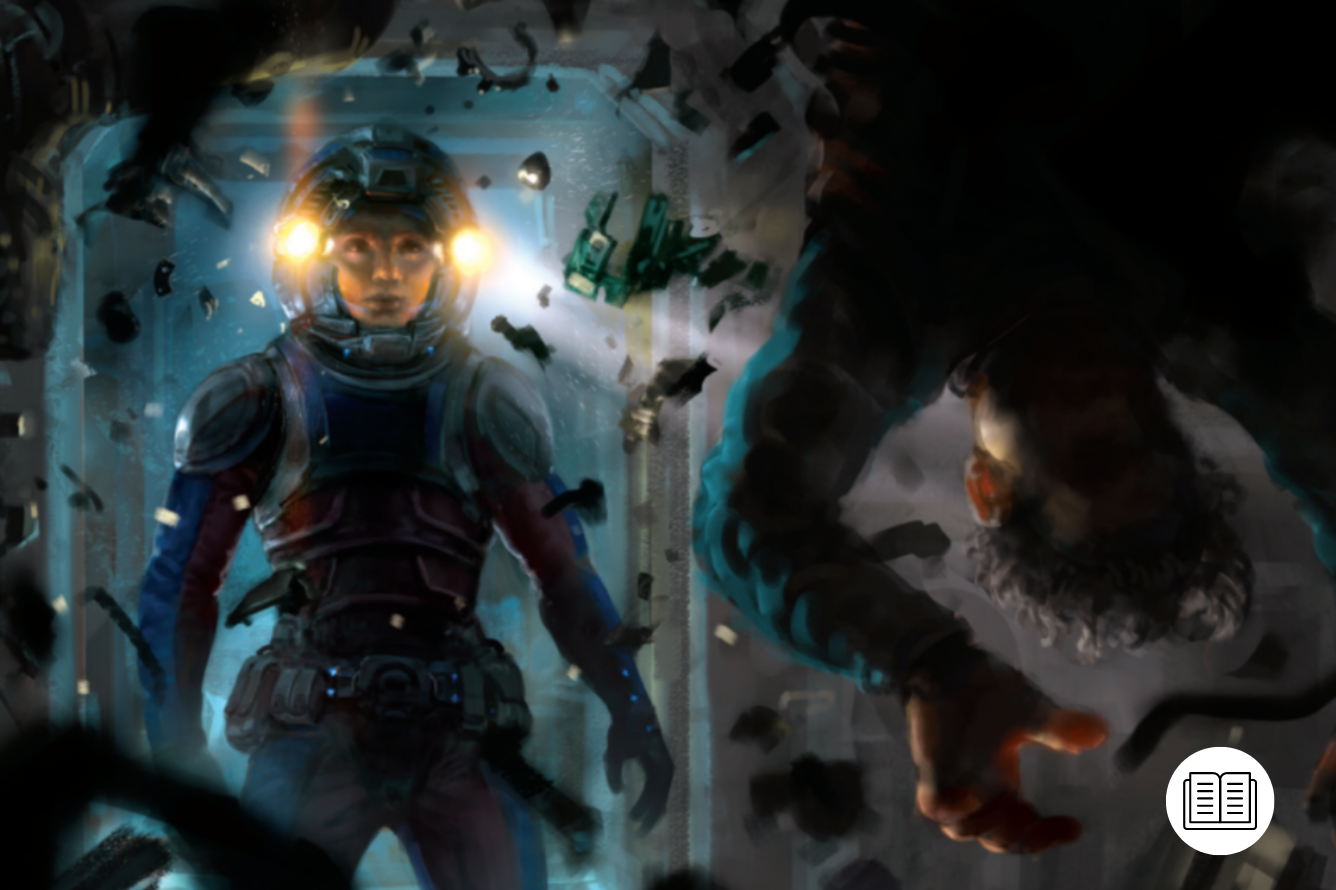
Million Dollar (Kickstarter) Baby
At the end of 2021, Mothership ‘arrived’. It made the cover of Rolling Stone, or played the MTV Awards, or whatever your analogy of choice is with a Kickstarter campaign for a boxed set that steamrollered through the USD$1million mark. The final tally, according to BackerKit, is an eye-watering $1,676,936 from 17,719 backers.
“Our first Kickstarter, for Two Rooms and a Boom, also wildly exceeded our expectations,” says McCoy. “We didn’t want to be spinning our wheels or running around freaking out, so we had an idea in mind: ‘Okay if this thing goes insane, what’s our approach?’
“The worst thing you can be doing during the hype and crazy of a Kickstarter is to start trying to feed the beast. You end up making wild promises you can’t keep.”
“We were lucky and we were prepared to be lucky,” says McCoy. “A number of factors broke our way. We have an amazing team, and indie RPG stars like Jarrett Crader, Fiona Geist, Donn Stroud, and Luke Gearing all threw in heavy support early on when we were no one. We were still in the last days of G+ which helped us with early adopters. We were one of the first tabletop companies to really make Discord a priority. And we followed up our initial release with module after module after module.
“We’ve basically tried to support the game like it will be around for 30-plus years, and I think people are responding to that. All of these have contributed, but at the end of the day, I can’t stress enough how much the breakaway success of a game is ultimately out of your control. We showed up and prepared for an opportunity and opportunities kept coming.”
Part of what helped maintain that level of interest is aside from releasing their own adventures and supplements – such as A Pound of Flesh, which includes rules for designing your own sketchy af space stations – there is a vibrant third-party scene. Part of the attraction is the lack of fussy proprietorial worldbuilding. Different creators have come in, offering radically different takes that share only a rules system and production values – generally zine-style booklets with a low price point that belies the richness of the illustration, graphic design, great typography, and rich paper stock.
“We’ve seen a lot of really great stuff from a lot of people who have never published before,” says McCoy. “They’ve stuck together as a small community and shared resources and helped promote each other. It’s really been incredible to witness.”
“Tuesday Knight Games has spent the last several years building a great community and their willingness to let people create their own content for their game has really boosted them.”
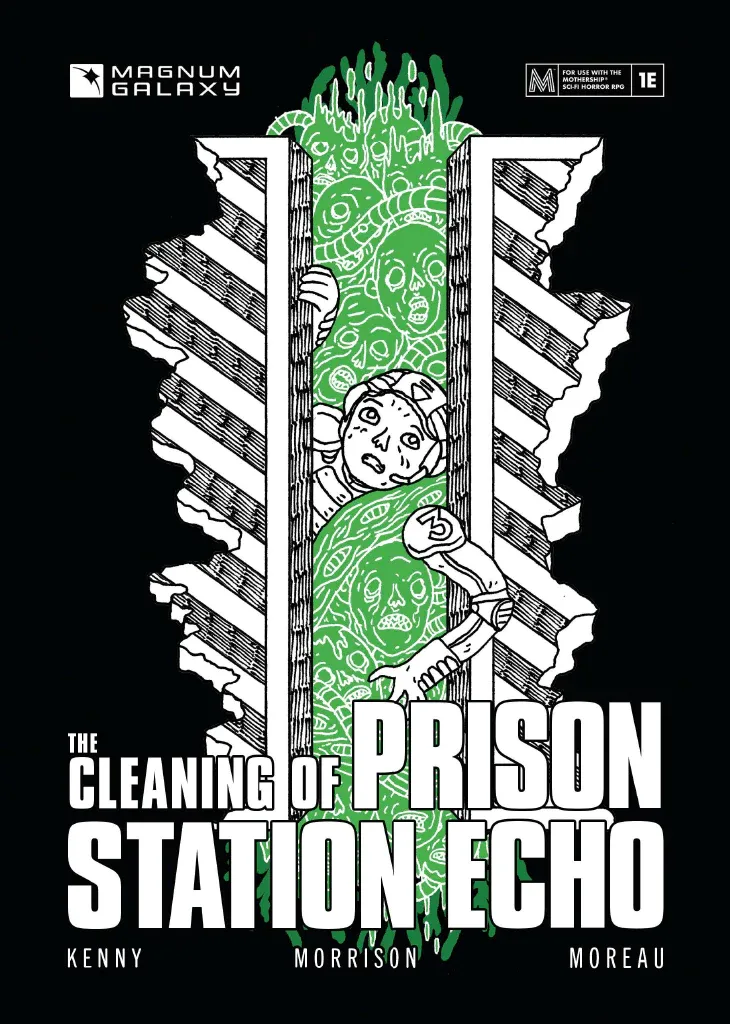
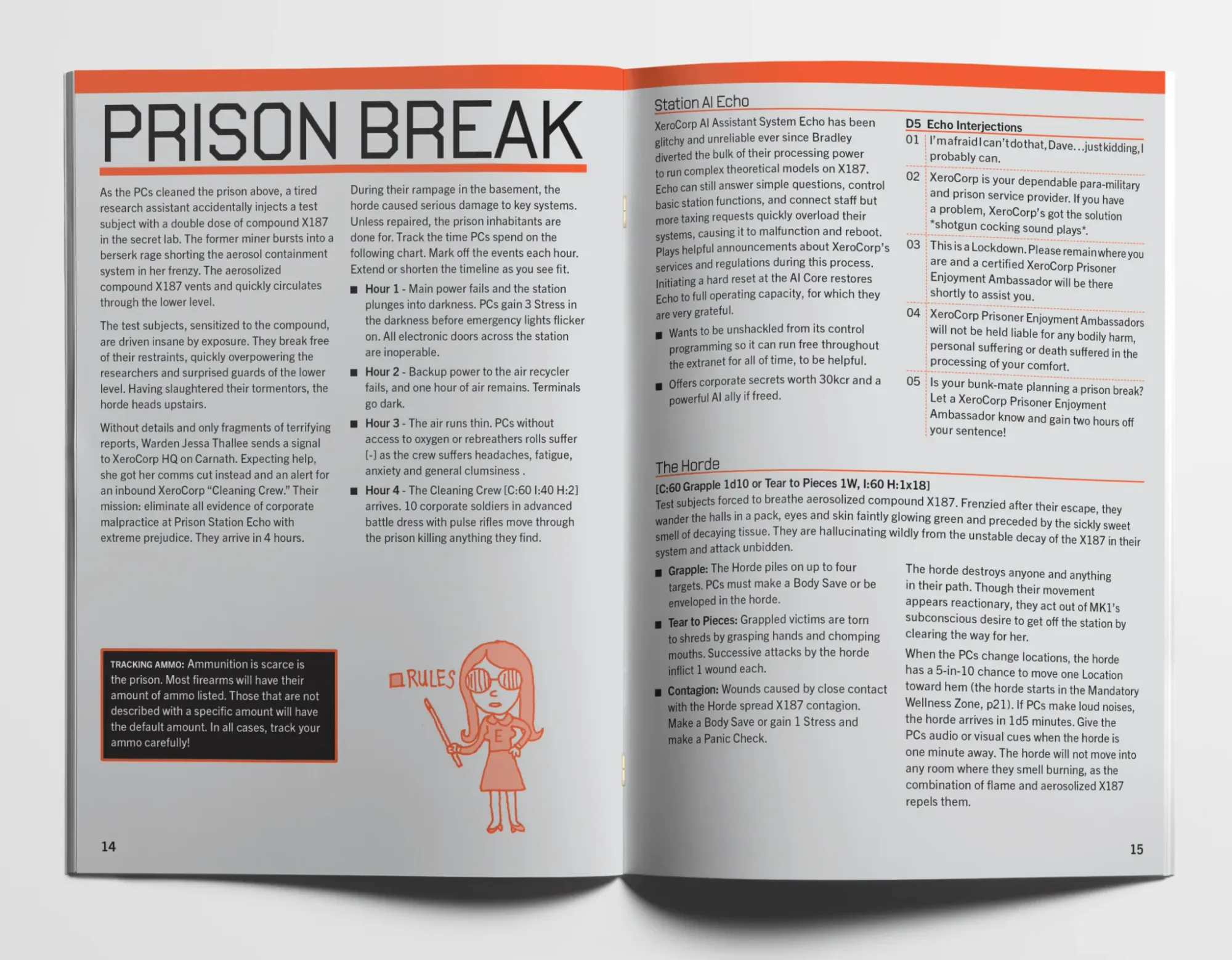
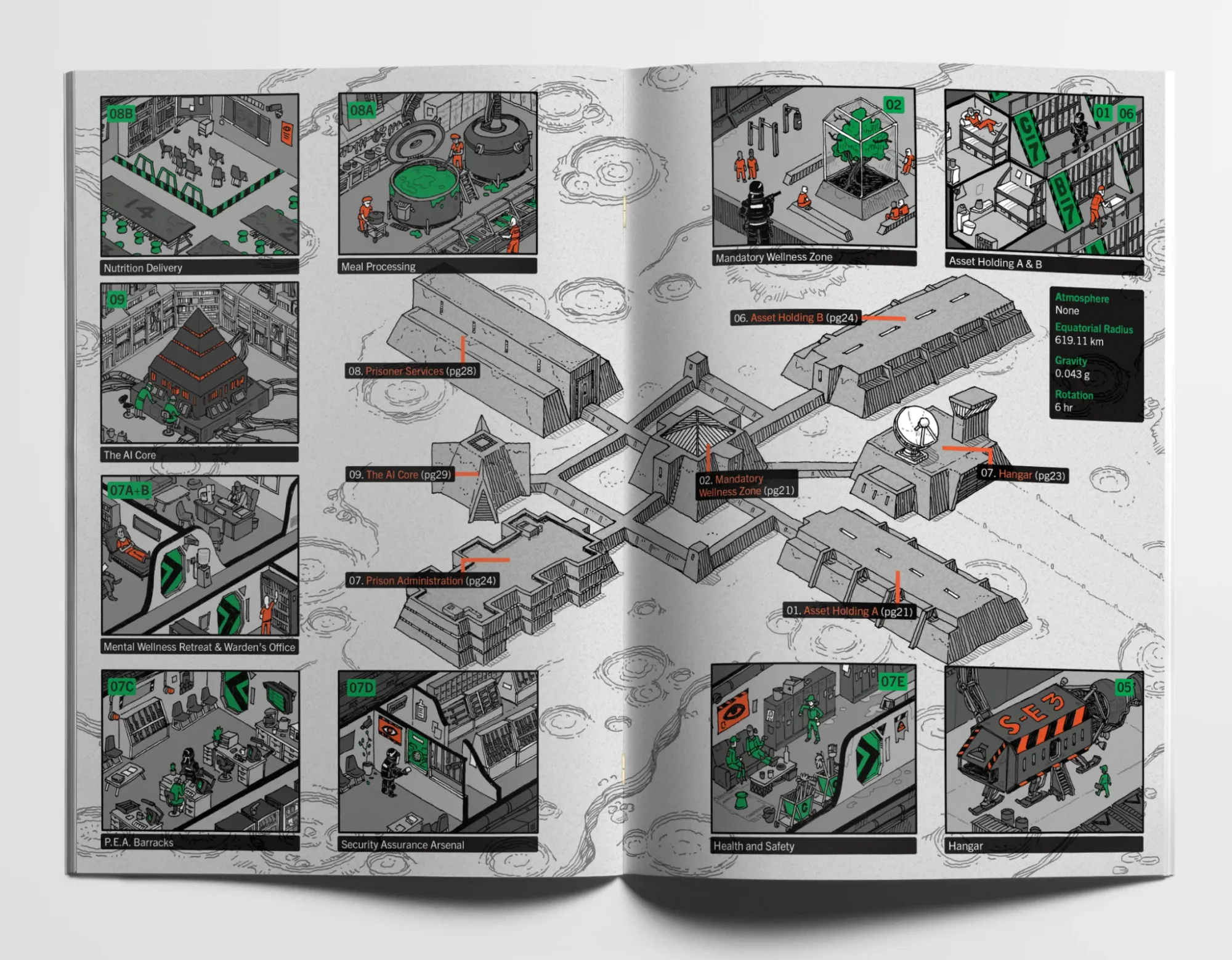
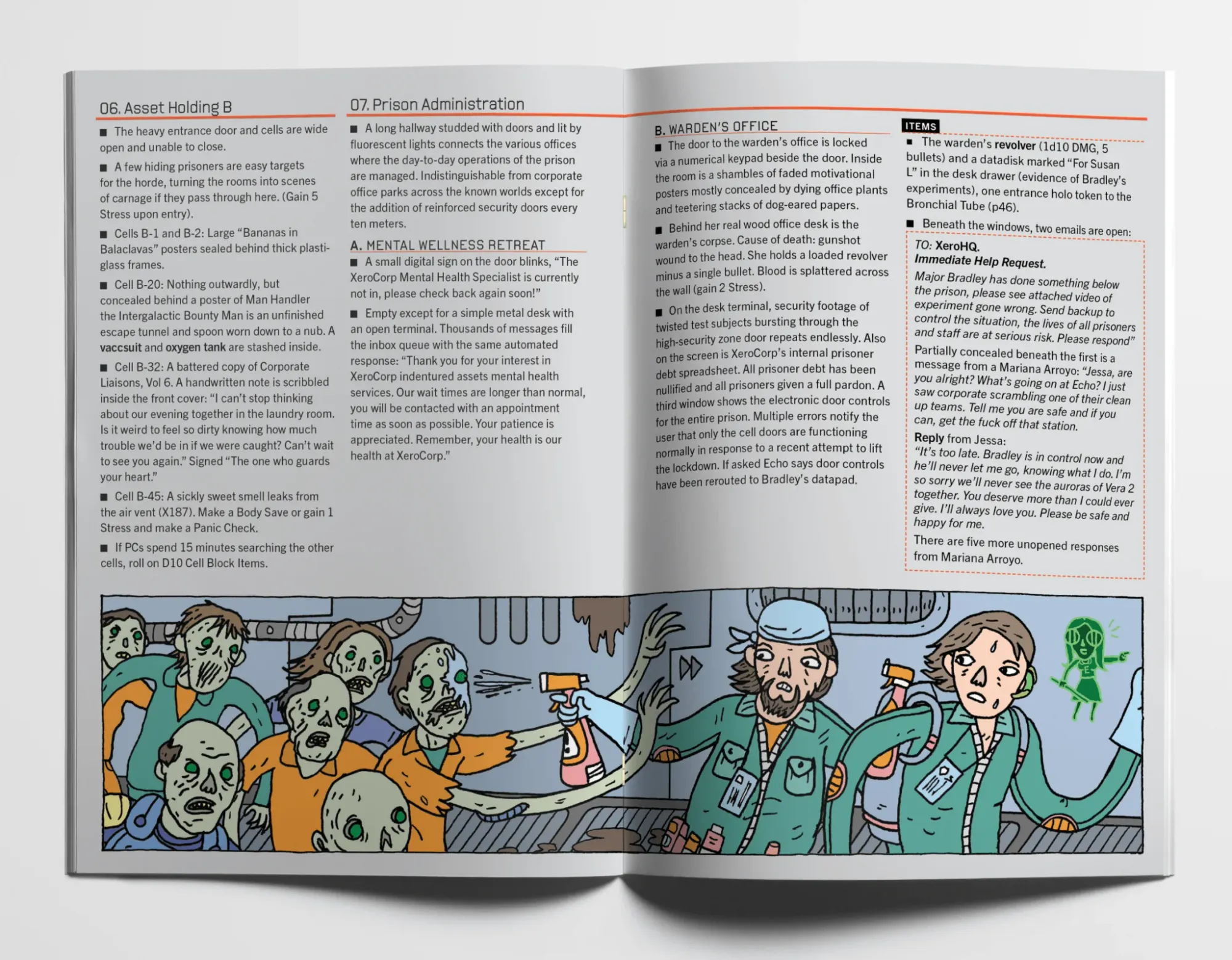
“I think people love the scrappy nature of the DIY RPG zine scene,” explains David Kenny, whose most recent Mothership module The Cleaning of Prison Station Echo (co-written with Haig Morrison), smashed its funding targets.
“Kickstarter has allowed me to collaborate with some awesome people around the world and together we created adventures of a quality that I couldn’t have dreamt of making on my own. Who doesn’t love to see that happen? Furthermore, the Kickstarter model makes every backer a participant in that process. Dying Hard on Hardlight Station and now The Cleaning of Prison Station Echo would not exist if it weren’t for the Kickstarter backers. As a backer of many zines myself, I can say firsthand that it is super gratifying to be a part of another creator’s journey from vision and first draft to printed adventure that you can hold in your hands.
“Honestly, I’m getting a little emotional typing this as I think about when the first big box of Hardlight Station zines came in. Unpacking them took me back to Christmas morning as a kid – and that joy is a feeling I’ve chased my whole adult life.”
Kenny’s sentiments are echoed by Alfred Valley, whose Thousand Empty Light is an outlier in a field of outliers: a very British sort of alienation that manifests in a design aesthetic like a hellish public information film, complete with a synthesizer score. The solo play unfolds like journalling, as you describe your reactions and theories about the sights you encounter on your journey into the depths of an underwater tunnel.
“In the last few years, there has been an explosion of new creators into the indie RPG scene,” he says. “With the extent of software, community knowledge-sharing, and online print services, never before has making a zine been so accessible. Kickstarter has become an undeniable marketing platform and hype machine for creators who may not otherwise have much of a following (as well as those who do). By highlighting the what of a zine, as opposed often to the who, small projects have been able to flourish and find audiences eager for cool stuff in print.
“For a game designer, the most gratifying thing is to see evidence of your game being played,” Valley continues. “The aesthetics get people in the door, the mechanics get people to sit down at the table. Some games are more style over substance, some are the other way round; both sides are completely valid. The challenge is finding that sweet spot in the middle that can reward players and designers alike.”
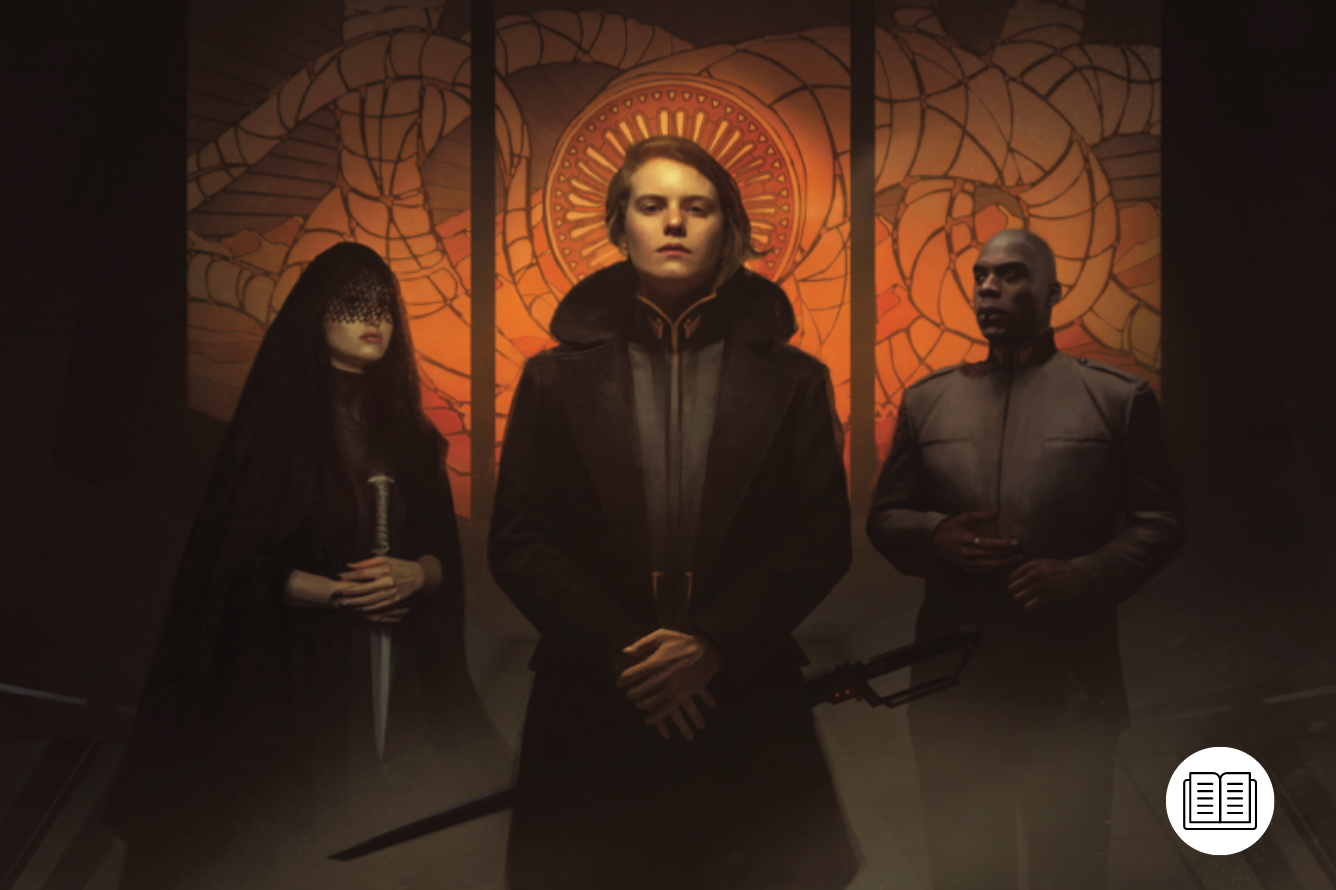
The Kicker in Kickstarter
There is criticism that Kickstarter is a false economy, where hype and aesthetics drive click, only for the finished products to go straight from fulfillment to eBay with the shrinkwrapped undisturbed.
“I don’t know who said this first,” reflects Kenny, “but I think the equation is simple: art and design bring the backers through the door, good writing is what keeps them and maybe even gets them to come back. I’ve seen flashy Kickstarter pages that grabbed a lot of attention and then failed to deliver with subpar content. I’ve also seen a ton of the opposite: killer content lost in a sea of text with no art or design to help it stand out. My philosophy for this has always been simple – design adventures that I think are truly awesome, and never put out anything that I can’t or won’t get behind one hundred percent. That’s what I did with Hardlight Station and that’s what I’m doing with Prison Station Echo and the response to this approach thus far has been positive.”
Like the hardcore punk scene of our hypothetical midwestern town, the cosmos around Mothership is at least self-policing in the sense that everyone knows everyone else, and Tuesday Knight effectively run the distro and the basement venue that keeps chancers from using Kickstarter as a license to print money. There is an incentive to make sure the content is as meaningful as the design because all of them are working towards a common purpose in the building of the Mothership community – literally.
“For me,” says Kenny, “among many, the biggest support has been the Mothership Discord and the 3rd Party Publishers server that Ian Yusem started that was born out of that. Being part of that group has not only been helpful in figuring out the nuts and bolts of how to pull these big projects off but also a source of mental support – a network of people going through the same joys and challenges who completely understand the struggles we face as we bring our creations to light.”
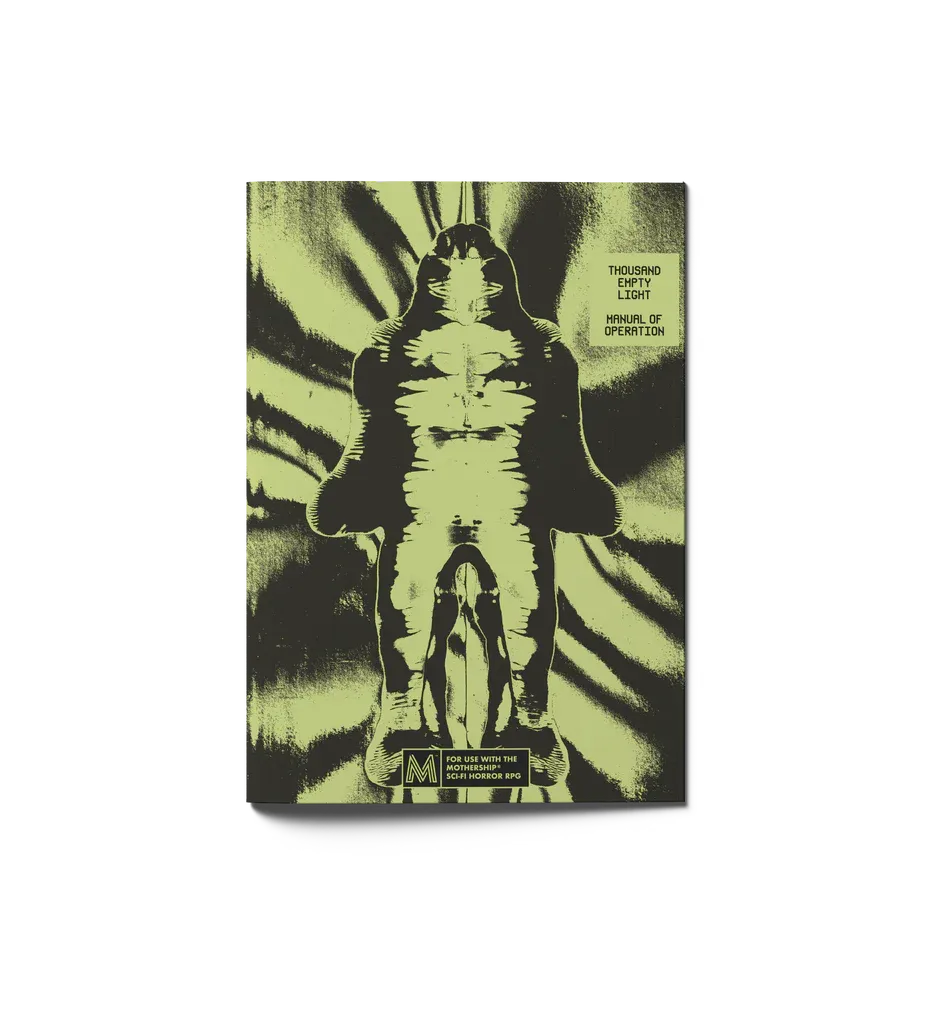
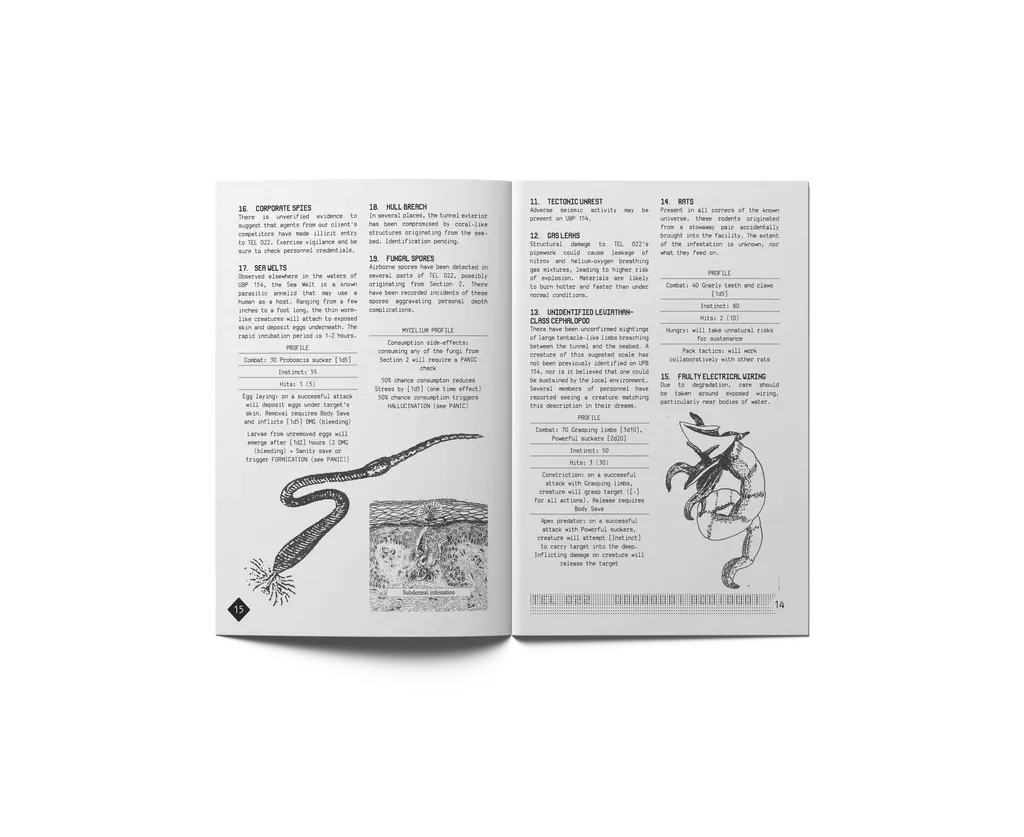
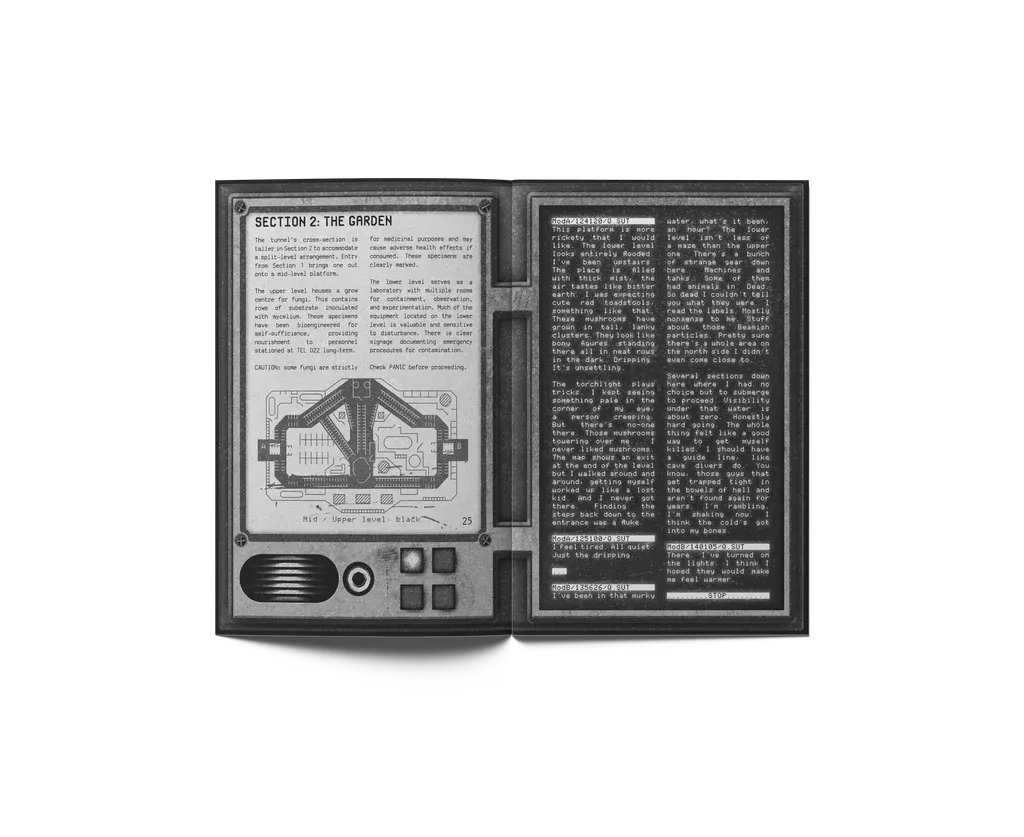
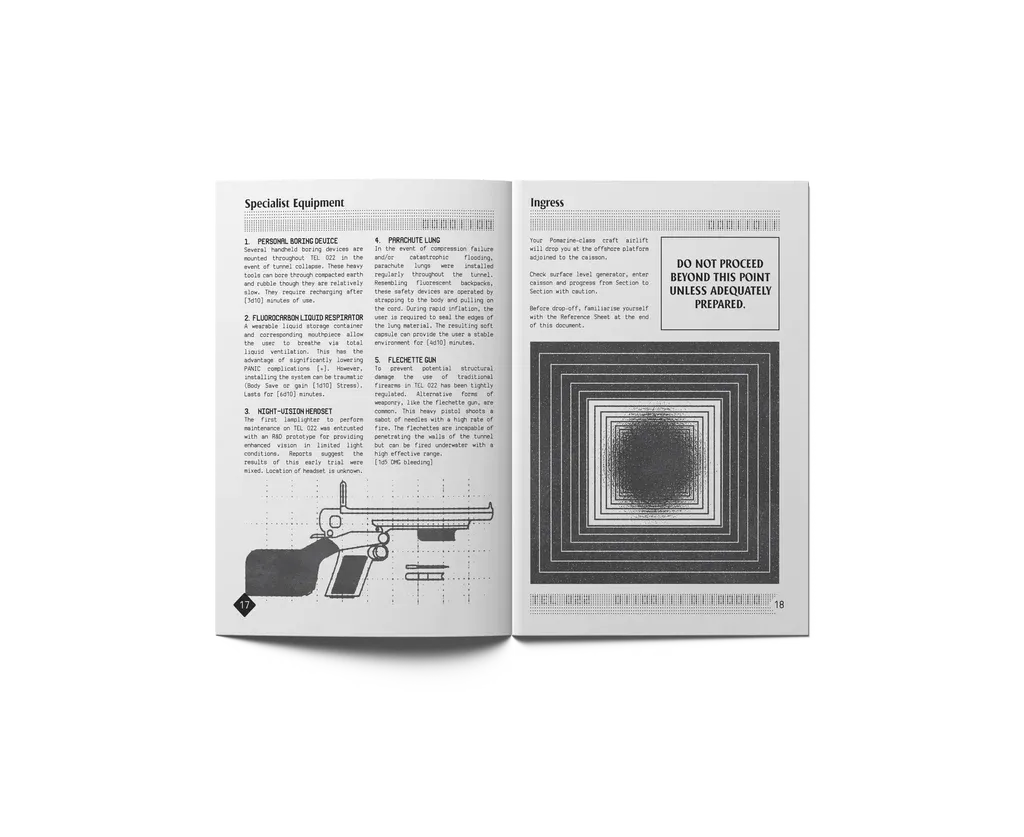
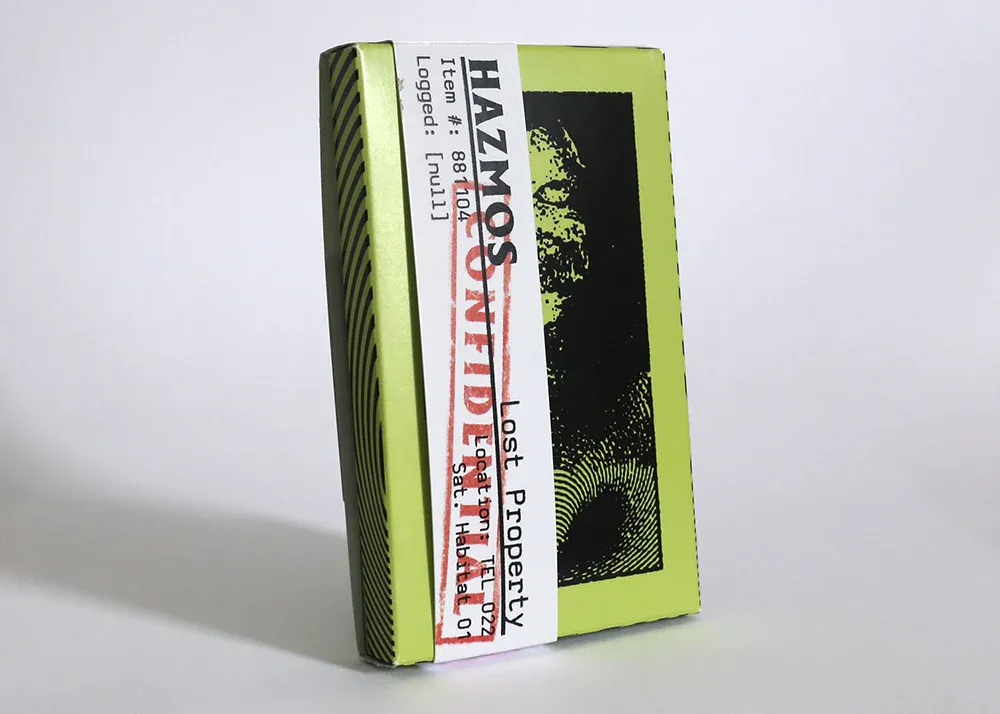
An OSR veteran whose previous works of art include the post-apocalyptic solo-play zine Lay on Hands and minimalist dungeon crawl Ossuary, Alfred Valley also singles out the incredible support network:
“The thing that first attracted me to Mothership was the prolific and supportive community of third-party content creators. The collective tinkering within and around the boundaries of the game system spoke to my own approach of seeing what I can get away with in terms of game design experimentation!”Alfred Valley
As the last word, the interviewees are asked for their advice for running the perfect Mothership game. Both Sean McCoy and David Kenny stress the importance of communicating expectations on both sides of the table when it comes to horror.
“I think the key to remember is that at its core we’re interested in fun,” answers McCoy. “Players being scared is largely on them and where they’re at and whether they’re open to experiencing that kind of emotion. Talk with your players about what they want and see if you can hit that, but don’t feel bad if no one is scared to play your game. The setting and the environment are sci-fi horror, but in my experience, the mood at the table is almost always laughter and shenanigans, no matter what the genre is.”
“Discussing tone and expectations up front,” agrees Kenny. “This is true of any RPG session but doubly so with Mothership because of the horror and stress elements. Players need to be prepared for their characters to freak out and probably die and not only be prepared for it but excited for the mayhem. When you understand that the goal of a night playing Mothership is more or less to collaboratively play out your own sci-fi horror movie seeing characters panic and get torn up by the monster of the week becomes central to the fun.”
This article was first published on July 28, 2022, on the original Companion website.
The cost of your membership has allowed us to mentor new writers and allowed us to reflect the diversity of voices within fandom. None of this is possible without you. Thank you. 🙂







